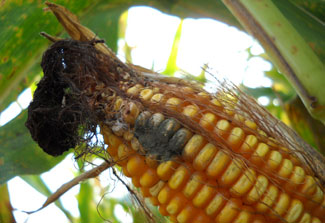Scientists study foodborne carcinogens called aflatoxins
March / April 2016 | Volume 15, Issue 2

Photo courtesy Mark Weaver, USDA
Aflatoxin-infected crops, mostly found in developing countries, can
cause liver cancer.
By Shana Potash
More than 5 billion people in the developing world are at risk of eating food contaminated with fungal poisons known as aflatoxins, according to a report jointly issued by the WHO and CDC. Aflatoxins are a by-product of mold that can grow in corn, nuts, cereals and other crops. They've been implicated in hundreds of poisoning deaths and are linked to liver cancer.
Contamination can happen anywhere and occur any time during the production process, from pre-harvest to storage. Wealthy countries have agricultural technology and regulatory policy to reduce the chance of dangerous products reaching consumers. That’s not the case in most developing countries, especially where subsistence farming is prominent.
The
National Institute of Environmental Health Sciences (NIEHS) has funded research that’s helped scientists better understand how the poisons work, how they affect the body, and how the body might protect itself.
Many of the studies have taken place in China and Africa, where the problem is most prevalent. Seventy percent of the people who become ill from aflatoxins live in the Western Pacific region, which includes China, according to the
WHO’s recently published report on foodborne diseases. More than 10,000 people in the region develop aflatoxin-induced liver cancer each year and nine out of 10 of them die from it.
Meanwhile in Africa, chemical hazards including aflatoxins cause a quarter of deaths from foodborne disease, the WHO reports. Kenya in particular has
suffered widespread exposure to aflatoxins and multiple poisoning outbreaks since 2004, resulting in nearly 500 acute illnesses and 200 deaths, according to CDC data.
NIEHS-funded scientists have established the link between hepatitis B, longtime exposure to aflatoxins, and increased risk for liver cancer. The drug Oltipraz can counteract the poison and reduce the amount of aflatoxins circulating in the body, research shows. Investigators have also been examining chlorophyllin, a derivative of chlorophyll, the green pigment in plants, as a treatment for aflatoxin-induced liver cancer. Aflatoxins may also play a harmful role in child development, another research topic.
Another area that could be ripe for investigation is the impact of extreme weather on aflatoxins and other natural toxins, notes NIEHS senior advisor Dr. John Balbus. Heat stress, unusual drought and heavy rains, for example, may change the level of toxins produced by plant species and different kinds of food.
More Information
To view Adobe PDF files,
download current, free accessible plug-ins from Adobe's website.